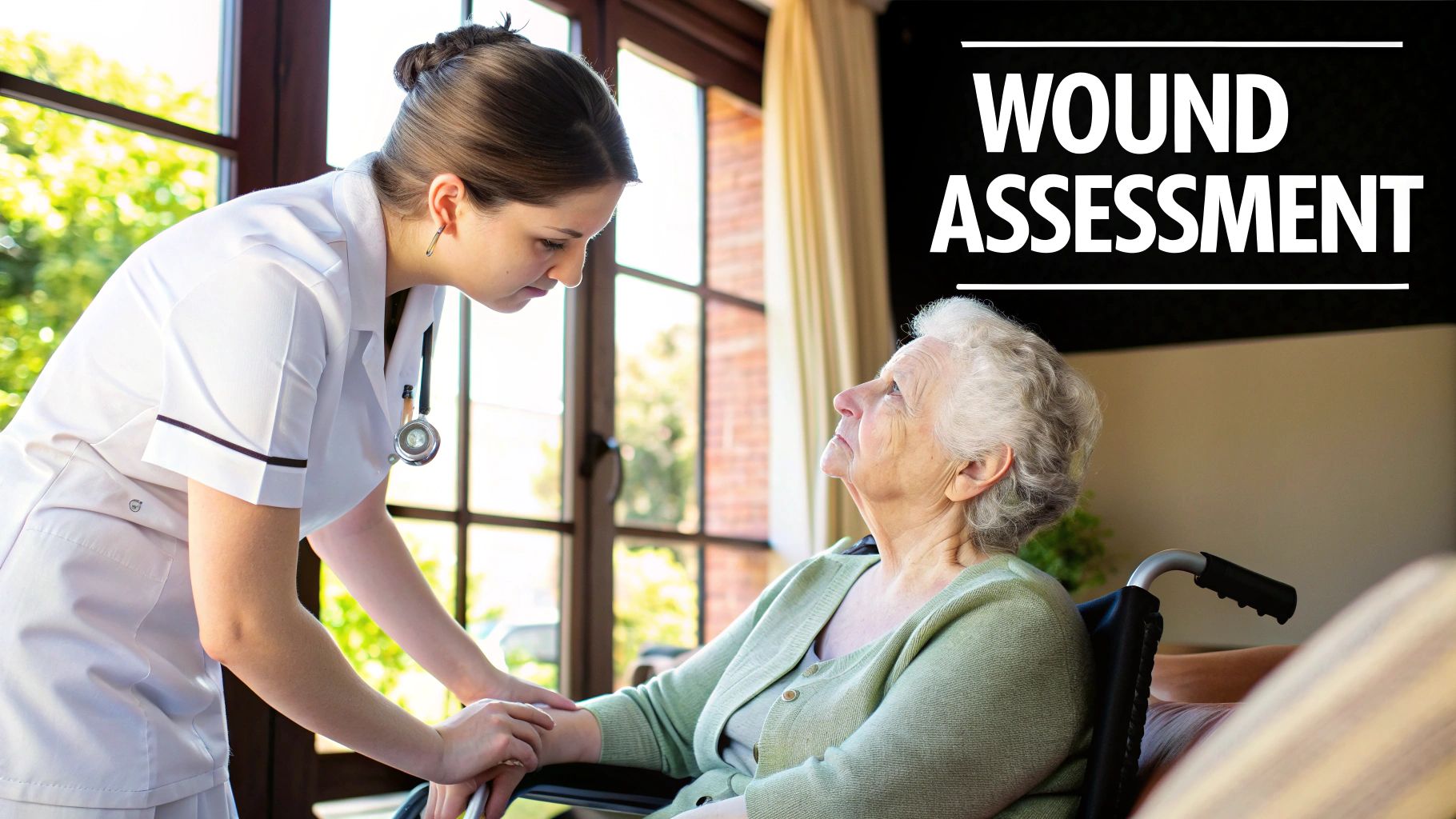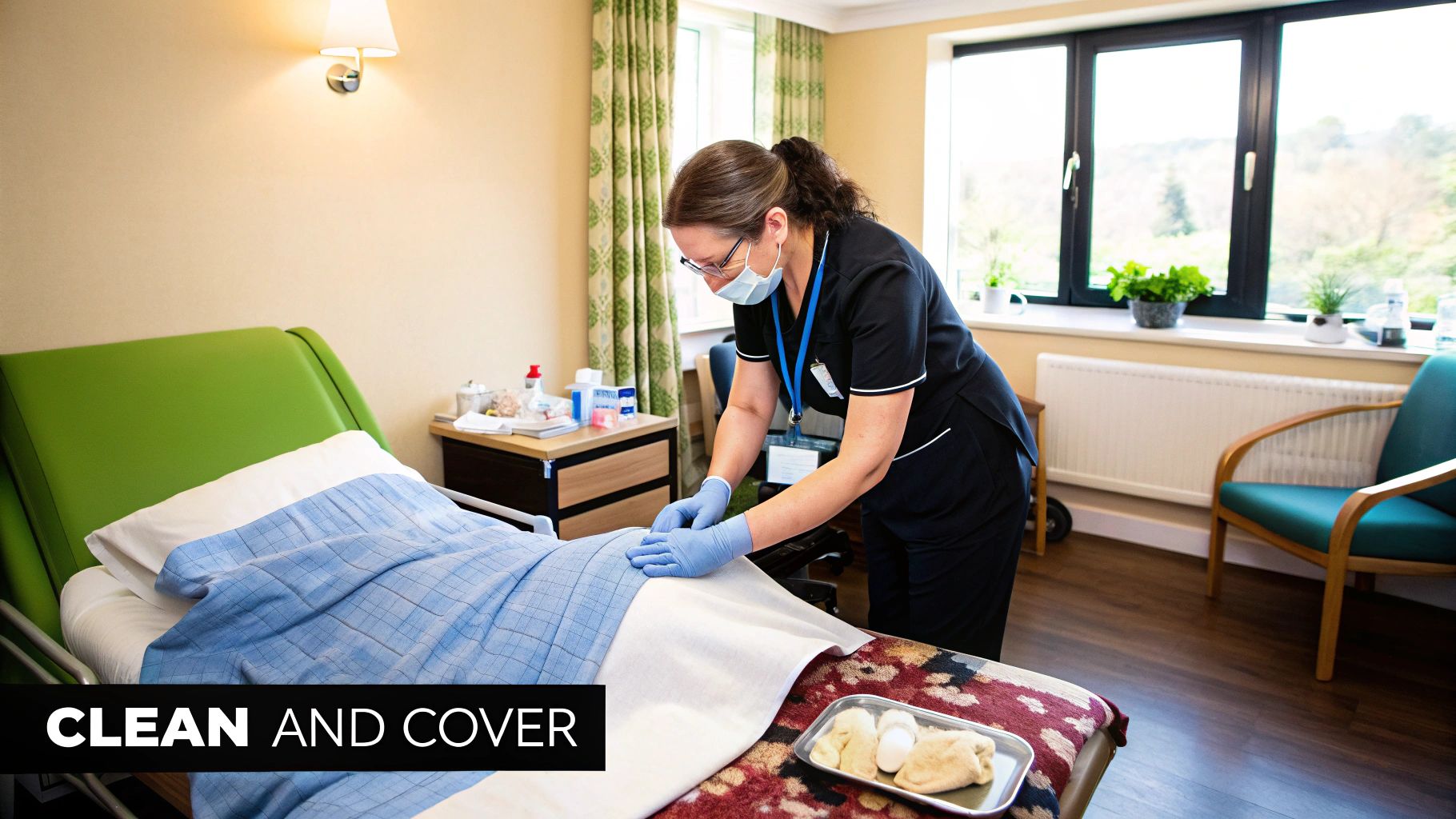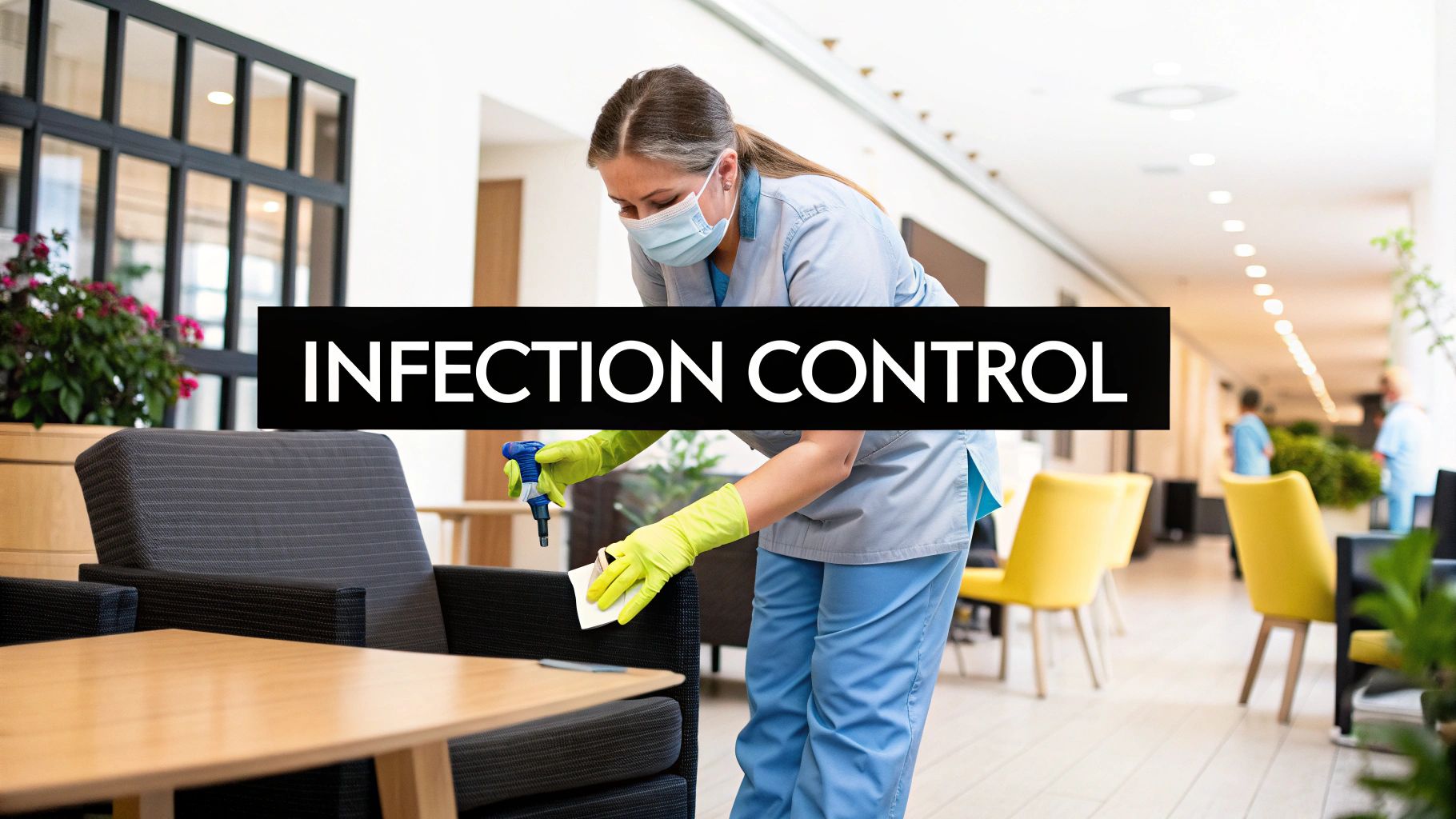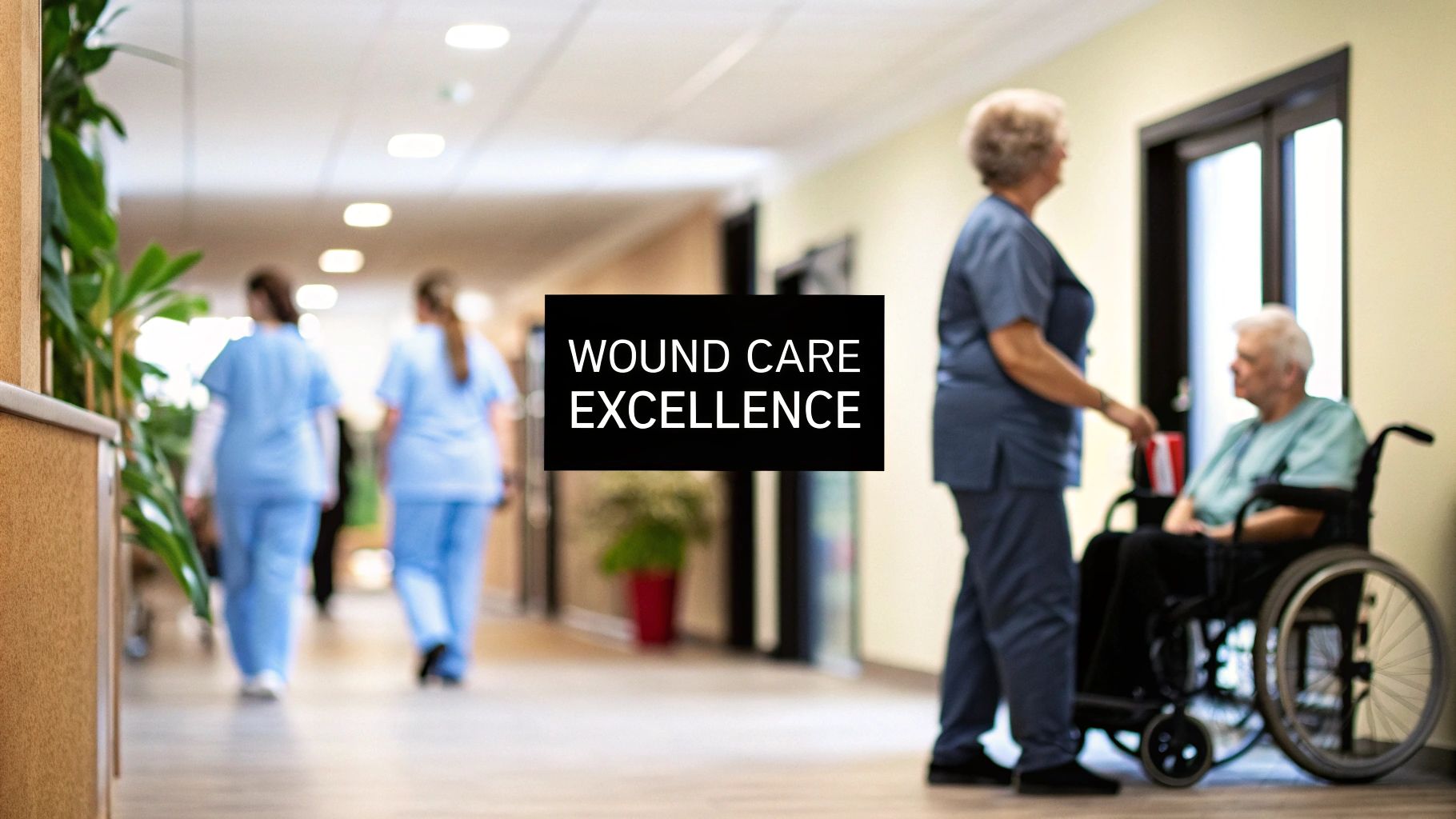The Hidden Crisis: How Wounds Impact Nursing Home Care

Wound care in nursing homes presents a significant challenge. Often unseen and underestimated, wounds can drastically affect a resident's quality of life and strain a facility's resources. This often-overlooked crisis demands a shift in our approach to wound care. We need to recognize the profound physical, emotional, and psychological impact of wounds.
One key aspect is the wide variation in wound prevalence rates. Some facilities report rates as low as 3.4%, while others report a staggering 32.4%.
This discrepancy highlights inconsistencies in care and the need for standardized protocols. Factors like resident demographics, underlying health conditions, and access to specialized care contribute to this variability.
Pressure ulcers are a major concern in nursing homes globally. Prevalence rates range from 3.4% to 32.4% across different countries, emphasizing the need for consistent methodologies and standards in wound care. Find more detailed statistics here.
In German nursing homes, chronic wounds were found in 7.8% of residents, with pressure ulcers accounting for 50.5% of these cases. Factors like limited mobility and diabetes mellitus are significant predictors of chronic wounds, including pressure ulcers. Healthcare systems must adapt strategies to address these specific risks. These varying statistics underscore the urgent need for better wound care practices in nursing homes.
The Psychological Toll of Wounds
Beyond physical discomfort, chronic wounds take a psychological toll. A wound can constantly remind residents of frailty, dependence, and loss of independence. This can lead to depression, anxiety, and social isolation.
The constant need for dressing changes and wound care disrupts a resident's routine and sense of normalcy. This further exacerbates their emotional distress.
The Burden on Caregivers
Wound care also burdens nursing home caregivers. Complex wound management is time-consuming, requiring specialized training and resources. The emotional strain of caring for residents with chronic wounds can lead to caregiver burnout and compassion fatigue.
Supporting staff through proper training, adequate resources, and emotional support systems is crucial. Addressing this hidden crisis requires a multi-faceted approach that prioritizes both resident well-being and caregiver support. It starts with acknowledging the complex interplay of physical and psychological factors contributing to this challenge.
Identifying the Enemy: Wound Types and Assessment Mastery

Effective wound care in nursing homes depends heavily on accurately and quickly identifying different wound types. This is critical because each type requires a unique treatment approach. Early misidentification can lead to improper treatment and longer healing times. This section explores how mastering wound assessment leads to optimal wound care in nursing homes.
Common Wound Types in Nursing Homes
Several wound types are frequently seen in nursing home residents. Pressure ulcers, also known as bedsores, develop from prolonged pressure on the skin. These are especially common in residents with limited mobility.
Another frequent occurrence is skin tears, resulting from the fragility of aging skin. Even simple actions like bumping into furniture or removing adhesive bandages can cause these tears.
Diabetic ulcers pose a significant challenge, particularly for residents with uncontrolled diabetes. These ulcers often appear on the feet and lower legs, healing slowly due to poor circulation.
While less frequent than pressure ulcers or skin tears, surgical wounds require careful monitoring and specialized care within the nursing home environment. Accurate identification is essential for developing effective treatment plans. For example, a surgical wound may need a different dressing than a pressure ulcer.
Studies show skin tears account for 10.3–12.8% of all wounds in North American skilled nursing facilities, emphasizing the need for diligent management. This prevalence is consistent across age groups, highlighting the need for targeted wound care strategies. Learn more about skin tear prevalence. These statistics underscore the significance of skin tears in nursing home wound care.
The following table provides a comparison of common wound types encountered in nursing home settings:
Common Wound Types in Nursing Home Residents
| Wound Type | Prevalence (%) | Primary Risk Factors | Key Assessment Parameters | Prevention Priorities |
|---|---|---|---|---|
| Pressure Ulcers | Varies widely; estimates range from 3% to 28% depending on the population and assessment tools | Immobility, poor nutrition, moisture, friction, shear | Location, size, depth, stage (I-IV), tissue type, exudate | Frequent repositioning, pressure-relieving surfaces, skin protection |
| Skin Tears | 10.3-12.8% in North American skilled nursing facilities | Thinning skin due to aging, medications (e.g., corticosteroids), dry skin, friction | Location, size, depth, presence of flap, bleeding, signs of infection | Gentle handling, moisturizing skin, protective clothing, avoiding adhesive tapes |
| Diabetic Ulcers | Prevalence varies, but foot ulcers affect up to 25% of people with diabetes at some point | Peripheral neuropathy, peripheral artery disease, foot deformities, poorly fitting shoes | Location (often on feet), size, depth, presence of infection, signs of ischemia (reduced blood flow) | Blood sugar control, regular foot exams, proper footwear, prompt treatment of any foot injuries |
| Surgical Wounds | Prevalence varies depending on surgical procedures performed | Surgical incision, underlying medical conditions, infection | Location, size, depth, approximation of wound edges, presence of sutures or staples, signs of infection, drainage | Aseptic surgical technique, proper wound closure, appropriate dressings, post-operative care |
This table summarizes the prevalence, risk factors, key assessment parameters, and prevention priorities for each wound type. Understanding these differences is crucial for effective wound management.
Mastering Wound Assessment Techniques
Accurate wound assessment is the foundation of effective wound care. It involves more than just looking at the wound; it requires a systematic approach to gather detailed information.
- Wound location: Pinpointing the wound's location can offer clues about its cause.
- Wound size: Measuring length, width, and depth provides crucial data for tracking healing.
- Wound bed appearance: Observing the color and texture helps determine the stage and potential infection.
- Surrounding skin: Examining the skin around the wound reveals signs of inflammation or maceration.
This comprehensive assessment allows nurses to classify wounds accurately and make informed treatment decisions. For instance, an infected wound requires a different approach than a clean wound.
The Role of Documentation and Technology
Thorough documentation is essential for tracking progress and ensuring consistent care. Using clear and concise language ensures effective communication among healthcare professionals.
Mobile technology like wound imaging apps can significantly improve documentation accuracy and efficiency. These tools allow for easily recording wound characteristics and sharing information among the care team, which leads to better treatment decisions and improved patient outcomes. Accurate wound assessment is a vital skill for all nursing home staff involved in wound care.
Prevention Protocols That Actually Work in Nursing Homes

Preventing wounds in nursing homes requires a proactive, multifaceted strategy. It's more than just following best practices; it's about building a culture of prevention that empowers staff and prioritizes residents' well-being. This section explores practical strategies that successful nursing homes use to minimize wound occurrences.
Customized Risk Assessment: Predicting Before Problems Develop
Early identification of at-risk residents is crucial for successful wound care. Using a standardized risk assessment tool, like the Braden Scale, is a solid starting point. But high-performing facilities go further, customizing these tools to reflect their residents' unique needs.
For instance, a facility with many diabetic residents might add risk factors related to diabetic neuropathy and foot care to their assessments. This allows for more accurate predictions of potential wound development.
The Power of Environmental Modifications
Simple environmental changes can have a big impact on wound prevention. Consider how easy it is to bump into furniture, especially for residents with mobility issues. Padding sharp corners and creating wider pathways can minimize skin tears.
Maintaining the right microclimate around the resident is also important. Appropriate room temperature and humidity levels prevent dry skin, a major factor in skin tears and pressure ulcers. This creates a comfortable, healing environment.
Holistic Prevention: Nutrition, Mobility, and More
Wound prevention isn't just about skin care; it's about overall well-being. Nutrition plays a vital role. A balanced diet rich in protein and essential vitamins supports healthy skin.
Mobility, even in small amounts, improves circulation and reduces pressure points. Encouraging regular movement, from chair exercises to short walks, can significantly lower the risk of pressure ulcers. This also boosts overall health and well-being.
Practical Workflows for Busy Staff
Implementing these strategies doesn't have to overwhelm busy staff. The key is developing practical workflows that fit into existing routines.
- Regular Skin Checks: Incorporate quick skin checks into daily hygiene routines.
- Repositioning Schedule: Use a consistent repositioning schedule for bed-bound residents.
- Moisture Management: Apply moisture barriers and absorbent products to keep skin dry and prevent maceration.
These simple, consistent steps can significantly reduce wound incidence. For more information on treating different wound types, visit Rapid Wound Care: Treatment Approaches. Prioritizing prevention improves resident outcomes and reduces staff burden.
Treatment Approaches: Selecting the Right Solutions

When prevention isn't enough, effective treatment becomes crucial for residents in nursing homes. Choosing the right approach requires careful evaluation, going beyond product marketing to understand what truly works. This section explores how to select the most appropriate wound care solutions in nursing home settings.
Balancing Effectiveness With Practicality
Finding the right treatment means balancing effectiveness with real-world limitations. Advanced therapies used in hospitals might not be feasible in nursing homes due to staffing and budget constraints.
For example, negative pressure wound therapy (NPWT), while effective, requires specialized equipment and training. Negative Pressure Wound Therapy Frequent dressing changes, though beneficial, can be time-consuming for busy staff. This emphasizes the need for treatments that are both effective and practical within the nursing home environment.
Navigating the Decision Tree: Dressings, Infection, and Pain
Successfully treating wounds involves navigating a complex decision tree. This begins with choosing the right dressing. The ideal dressing promotes a moist environment while managing exudate and preventing infection.
However, dressing selection is only one part. Infection management is crucial, as infected wounds heal much slower. This requires vigilant monitoring and prompt intervention. Pain control is also essential, as chronic wounds can be very painful. Effective pain management improves comfort and promotes healing.
When To Seek Specialized Help
Nursing home staff can manage many wounds, but some cases need specialized consultation. Deep or complex wounds, non-responsive wounds, or wounds with suspected complications often benefit from a wound care specialist.
Recognizing when to consult a specialist improves outcomes and prevents complications. This ensures residents receive the appropriate level of care. Rapid Wound Care offers specialized expertise within nursing homes. They provide a valuable resource for managing complex cases and supporting nursing home staff. Learn more about how Rapid Wound Care helps nursing homes.
Empowering Staff Through Practical Guides
Equipping staff with practical tools and resources is vital for effective wound care. Decision matrices or algorithms can guide staff through dressing selection for common wound types. These tools simplify decision-making and ensure consistent treatment.
To help guide nursing home staff in making appropriate dressing selections, the following table offers a quick reference based on wound characteristics and treatment goals.
Wound Dressing Selection Guide for Nursing Home Staff
| Dressing Type | Best For | Application Technique | Change Frequency | Special Considerations |
|---|---|---|---|---|
| Hydrocolloids | Partial- and full-thickness wounds, granular or necrotic wounds, minimal to moderate exudate | Apply directly to the wound, ensuring good contact with the surrounding skin. | Every 3-7 days, or as needed if leakage occurs. | Not suitable for heavily infected wounds. |
| Alginates | Moderate to heavy exudate, infected wounds, cavity wounds | Pack loosely into the wound cavity. | Daily or every other day, depending on the amount of exudate. | Can dry out if exudate is minimal. |
| Foams | Moderate to heavy exudate, partial- and full-thickness wounds, cavity wounds | Apply directly to the wound, ensuring the foam covers the entire wound bed. | Every 1-3 days, or as needed if leakage occurs. | Not suitable for dry wounds. |
| Hydrogels | Dry wounds, necrotic wounds, painful wounds | Apply a thin layer to the wound bed. | Daily or every other day. | May require a secondary dressing to secure in place. |
This table provides a simplified guide for choosing the right dressing. Empowering staff with such tools significantly improves the quality of wound care provided in nursing homes.
Building a Wound Care Program That Thrives Despite Challenges
Creating a successful wound care program in a nursing home takes more than just medical expertise. It requires systems that work well within the realities of this setting. This means tackling challenges like staff turnover, budget limitations, and constantly evolving regulations. This section offers a plan for building a strong wound care program that not only survives these challenges but thrives.
The Interdisciplinary Approach: Distributing Responsibility
Successful wound care programs flourish through teamwork. They use an interdisciplinary approach, bringing together nurses, physicians, dietitians, therapists, and even the residents themselves. Clearly defined roles ensure nothing is overlooked. This collaborative effort promotes shared responsibility and accountability.
For instance, nurses might handle initial assessments and dressing changes, while dietitians concentrate on nutritional support to promote healing. This division of labor ensures comprehensive care.
Documentation Strategies: Balancing Clinical and Regulatory Needs
Documentation is crucial but can be a burden. Efficient systems are key. Effective programs utilize user-friendly tools and streamlined processes that meet both clinical and regulatory needs without overwhelming staff. This allows for efficient tracking of wound progress and ensures compliance.
Mobile technology, like wound imaging apps, can simplify documentation and boost accuracy. These apps allow for quick and easy recording of wound characteristics, improving communication among the care team.
Effective Wound Rounds and Escalation Protocols
Regular wound rounds are fundamental to proactive care. They offer chances to detect potential problems early and intervene promptly. Clear escalation protocols ensure complex wounds get the attention they need from specialists or wound care experts.
These protocols specify when to consult a wound care specialist, like those at Rapid Wound Care. This ensures residents receive the appropriate level of care when necessary. For example, a non-healing wound or signs of infection might trigger a specialist consultation. This proactive approach prevents complications and promotes faster healing.
Staff Education: Transforming Knowledge Into Practice
Ongoing staff education is vital for maintaining high standards. Effective training goes beyond lectures; it includes interactive learning, case studies, and hands-on practice. This practical approach translates knowledge into usable skills.
Creating a culture of continuous learning empowers staff to stay up-to-date on the latest best practices in wound care. This dedication to education leads to better resident care and improved outcomes.
Measuring Success: Metrics That Matter
A thriving wound care program tracks its progress. This involves measuring key metrics such as wound healing rates, infection rates, and resident satisfaction. Tracking these metrics allows programs to pinpoint areas for improvement and demonstrate the program's effectiveness. This data-driven approach helps optimize the program and ensures continued positive outcomes. It also demonstrates the program's value and justifies continued investment in excellent wound care. For expert wound care in your facility, contact Rapid Wound Care.
The Business Case: Economic Impact of Excellence in Wound Care
Superior wound care in nursing homes isn't simply about resident well-being; it's a fiscally responsible strategy. Proper wound management significantly impacts a nursing home's financial health, affecting operational costs and public perception. This section explores the economic advantages of prioritizing excellent wound care.
Reduced Costs: Prevention is Key
Investing in preventative measures drastically reduces long-term costs. Regular maintenance, like a car tune-up, is less expensive than major repairs. Similarly, proactive wound care, like pressure ulcer prevention programs, minimizes expensive treatments like negative pressure wound therapy or extended hospital stays. These savings accumulate quickly, freeing up resources for other essential resident care aspects.
For example, preventing a single pressure ulcer can save thousands of dollars in treatment costs. This includes dressings, medications, specialized equipment, and staff time.
Staffing Efficiency: Optimized Workflows
Efficient wound care programs optimize workflows. Well-trained staff, equipped with the right tools and clear protocols, manage wounds effectively, spending less time on complex cases. Building a strong wound care program requires well-trained staff. Consider exploring resources like this article on Caregiver Training. This increased efficiency translates into substantial cost savings, allowing staff to focus on other resident needs.
Proper documentation also reduces paperwork time and ensures accurate record-keeping, further improving efficiency. This minimizes errors and improves communication among the care team.
Marketing Advantage: A Positive Reputation
Excellence in wound care becomes a powerful marketing tool. A strong reputation for effective wound management attracts referrals from hospitals and physicians. This positive image enhances a facility's community standing and builds trust with potential residents and families.
This results in higher occupancy rates and stronger financial positioning. Demonstrating a commitment to wound care distinguishes a facility and positions it as a leader in quality care.
Value to Payers: Demonstrating Value
High-quality wound care demonstrates value to payers, including Medicare and private insurance companies. Demonstrating positive outcomes, such as reduced hospital readmissions and faster healing, allows facilities to negotiate better reimbursement rates and secure favorable contracts.
This strengthens the nursing home's financial stability and allows continued investment in high-quality care. This focus on outcomes reinforces the business case for investing in wound care excellence. The economic and healthcare impact of wound care in nursing homes is substantial and growing. The global wound care centers market, valued at USD 41.9 billion in 2022, is projected to grow at a CAGR of 3.6% from 2023 to 2030. Explore this topic further here.
Regulatory Changes and Reimbursement: Staying Ahead
Regulatory changes often impact reimbursement models. Proactive nursing homes adapt to these changes, optimizing wound care programs to meet new requirements and maximize reimbursement. This proactive approach ensures financial stability and positions the facility for continued success.
By focusing on resident and payer outcomes, nursing homes demonstrate their wound care program's value and secure resources to provide exceptional care. For expert assistance in optimizing your wound care program, contact Rapid Wound Care.

